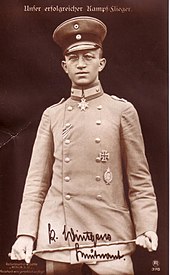Kurt Wintgens
Kurt Wintgens (born August 1, 1894 in Neustadt in Upper Silesia ; † September 25, 1916 at Villers-Carbonnel ) was a German fighter pilot in the First World War .
Life
Wintgens, whose late father had served as a lieutenant colonel , joined the Prussian Army's telegraph battalion No. 2 as a flag junior after graduating from high school in 1913 . He attended the war school in Hersfeld , moved into the field as a lieutenant and platoon leader on the Eastern Front at the outbreak of World War I and was awarded the Iron Cross, 2nd class. Wintgens, who was a member of the Aviation Society and who had designed model aircraft, reported to the air force early on . He only succeeded in doing this in 1915, when he went to the AHG Fokker Aeroplanbau flight school in Schwerin . Wintgens received a special permit that allowed him, as a spectacle wearer, to wear glasses with specially hardened lenses under his protective glasses.
Then he came to Aviation Department 67, which was deployed on the front in Lorraine . There he succeeded on July 1, 1915 as the first fighter pilot near Lunéville to shoot down an enemy aircraft with the newly deployed synchronized machine gun. The wounded French pilot, Capitaine Paul du Peuty, and his observer Sous-lieutenant de Boutiny, however, managed to land their Morane-Saulnier Parasol on the Allied side, so that Wintgens' aerial victory was not confirmed.
In mid-July, after another unconfirmed aerial victory, Wintgens was transferred to Feld-Flieger Department 48 near Mulhouse in Alsace , where he scored his first confirmed aerial victory, again against a Morane-Saulnier umbrella deck. Wintgens later came to the Combat Single Seat Command (KEK) Vaux , where he achieved further aerial victories as a fighter pilot. On June 24, 1916, Wintgens probably flew a Halberstadt D.II , he shot down the Nieuport 16 of the American aviator Victor Chapman , who was serving as a war volunteer in the Escadrille La Fayette , and thus achieved the first aerial victory against an American pilot.
Wintgens, after Oswald Boelcke and Max Immelmann, the most successful German fighter pilot to date after Oswald Boelcke and Max Immelmann with 14 recognized aerial victories , was awarded the Order Pour le Mérite on July 1, 1916 after eight aerial victories and joined the first newly established German fighter squadron at the end of August 1916 Jasta 1.
When used on 25 September 1916 in which he on an outdated Fokker monoplane as a wingman with his friend and squadmates Walter Höhndorf took over the escort of German reconnaissance aircraft, it was about 11 o'clock in the morning on Villers-Carbonnal at the Somme probably by Alfred Heurtaux ' SPAD S.VII of the French Escadrille SPA.3 shot down.
Kurt Wintgens probably achieved 22 aerial victories, 19 of which had been officially confirmed.
Commemoration
Kurt Wintgens was buried in St. Quentin with the participation of the commanding general and numerous flight officers. Fighter pilots dropped flowers over his grave and shot a salute with machine gun salvos. His body was later exhumed, transferred to Minden and buried there.
The Junkers Ju 52 / 3m D-AQUI of the Deutsche Lufthansa Berlin Foundation bears the name "Kurt Wintgens" in his memory.
literature
- Karl-Friedrich Hildebrand, Christian Zweng: The knights of the order Pour le Mérite of the First World War. Volume 3: P-Z. , Biblio Verlag, Bissendorf 2011, ISBN 3-7648-2586-3 , pp. 548-549.
- Werner von Langsdorff (Ed.): Flieger am Feind. Seventy-one German pilots tell. C. Bertelsmann Publishing House, Gütersloh 1934
- Hanns Möller: History of the knights of the order pour le mérite in the world war. Volume II: M-Z. Bernard & Graefe Verlag, Berlin 1935, pp. 512-513.
Web links
- Short biography on Flieger-Album.de ( Memento from September 22, 2010 in the Internet Archive )
- Hit list
- "On the heroic death of Fliegerleutnant Wintgens" in the German army report of September 26, 1916
Individual evidence
- ↑ Kurt Wintgens was born in Neustadt in Oberschlesien (Neustadt OS), Prussia and NOT in Neustadt an der Saale (Neustadt aS or Neustadt adS), Bavaria. This mistake appears repeatedly in secondary literature, but contemporary original sources always state Neustadt in Upper Silesia as Wintgens' place of birth. (See e.g. census of December 1, 1900 in the city of Minden, Volume I, page 549 ).
- ↑ cf. Report from Lowell Sun, Massachusetts / USA - November 17, 1916
| personal data | |
|---|---|
| SURNAME | Wintgens, Kurt |
| BRIEF DESCRIPTION | German fighter pilot in the First World War |
| DATE OF BIRTH | August 1, 1894 |
| PLACE OF BIRTH | Neustadt OS |
| DATE OF DEATH | September 25, 1916 |
| Place of death | Villers-Carbonnel |

